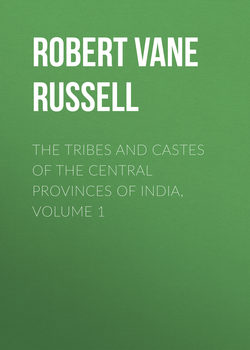Читать книгу The Tribes and Castes of the Central Provinces of India, Volume 1 - Robert Vane Russell - Страница 53
Part I.
Introductory Essay on Caste
Introductory Essay on Caste
50. Terms of relationship
ОглавлениеExogamy and totemism are found not only in India, but are the characteristics of primitive social groups over the greater part of the world. Totemism establishes a relation of kinship between persons belonging to one clan who are not related by blood, and exogamy prescribes that the persons held to be so related shall not intermarry. Further, when terms of relationship come into existence it is found that they are applied not to members of one family, but to all the persons of the clan who might have stood in each particular relationship to the person addressing them. Thus a man will address as mother not only his own mother, but all the women of his clan who might have stood to him in the relation of mother. Similarly he will address all the old men and women as grandfather or grandmother or aunt, and the boys and girls of his own generation as brother and sister, and so on. With the development of the recognition of the consanguineous family, the use of terms of relationship tends to be restricted to persons who have actual kinship; thus a boy will address only his father’s brothers as father, and his cousins as brothers and sisters; but sufficient traces of the older system of clan kinship remain to attest its former existence. But it seems also clear that some, at least, of the terms of relationship were first used between persons really related; thus the word for mother must have been taught by mothers to their own babies beginning to speak, as it is a paramount necessity for a small child to have a name by which to call its mother when it is wholly dependent on her; if the period of infancy is got over without the use of this term of address there is no reason why it should be introduced in later life, when in the primitive clan the child quickly ceased to be dependent on its mother or to retain any strong affection for her. Similarly, as shown by Sir J.G. Frazer in Totemism and Exogamy, there is often a special name for the mother’s brother when other uncles or aunts are addressed simply as father or mother. This name must therefore have been brought into existence to distinguish the mother’s brother at the time when, under the system of female descent, he stood in the relation of a protector and parent to the child. Where the names for grandfather and grandmother are a form of duplication of those for father and mother as in English, they would appear to imply a definite recognition of the idea of family descent. The majority of the special names for other relatives, such as fraternal and maternal uncles and aunts, must also have been devised to designate those relatives in particular, and hence there is a probability that the terms for father and brother and sister, which on a priori grounds may be considered doubtful, were also first applied to real or putative fathers and brothers and sisters. But, as already seen, under the classificatory system of relationship these same terms are addressed to members of the same clan who might by age and sex have stood in such a relationship to the person addressing them, but are not actually akin to him at all. And hence it seems a valid and necessary conclusion that at the time when the family terms of relationship came into existence, the clan sentiment of kinship was stronger than the family sentiment; that is, a boy was taught or made to feel that all the women of the clan of about the same age as his mother were as nearly akin to him as his own mother, and that he should regard them all in the same relation. And similarly he looked on all the men of the clan of an age enabling them to be his fathers in the same light as his own father, and all the children of or about his own age as his brothers and sisters. The above seems a necessary conclusion from the existence of the classificatory system of relationship, which is very widely spread among savages, and if admitted, it follows that the sentiment of kinship within the clan was already established when the family terms of relationship were devised, and therefore that the clan was prior to the family as a social unit. This conclusion is fortified by the rule of exogamy which prohibits marriage between persons of the same clan between whom no blood-relationship can be traced, and therefore shows that some kind of kinship was believed to exist between them, independent of and stronger than the link of consanguinity. Further, Mr. Hartland shows in Primitive Paternity92 that during the period of female descent when physical paternity has been recognised, but the father and mother belong to different clans, the children, being of the mother’s clan, will avenge a blood-feud of their clan upon their own father; and this custom seems to show clearly that the sentiment of clan-kinship was prior to and stronger than that of family kinship.
92
Vol. i. pp. 272, 276.
